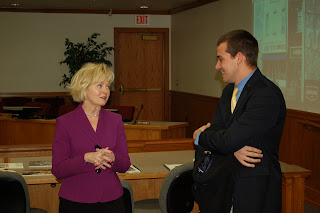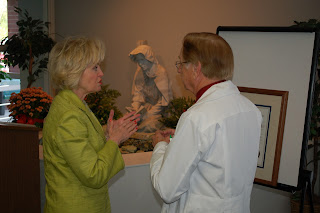Lt. Governor Skillman Announces:
Lift Truck Manufacturer to Grow Production in Henry County
NEW CASTLE, Ind. (Oct. 17, 2011) - Lt. Governor Becky Skillman joined executives from Crown Equipment Corporation, a manufacturer of materials handling equipment, today to announce that the company will expand its operations here, creating up to 150 new jobs by 2013.
The company, which makes a variety of lift trucks and hand pallet trucks for manufacturers and retailers, will invest more than $15 million to purchase and renovate the 982,000 square-foot former Metaldyne building and purchase new machinery to increase capacity in support of current operations.
 |
Lt. Governor Skillman announces a job expansion
for Crown Equipment in New Castle |
"Crown is a large, nationally-recognized company with many options to expand," said Skillman. "These new jobs could have landed somewhere else, but Indiana's low cost of doing business and Crown's continuing commitment to our state is once again creating opportunities for east central Indiana workers."
The company currently has more than 580 employees throughout its seven locations in Indiana. It plans to begin hiring additional manufacturing, maintenance and service personnel this fall to coincide with facility improvements and expanded manufacturing capacity.
"The New Castle facility gives Crown the needed floor space to support our expanding product line. In addition, the location is centrally located to our other facilities, which affords us some logistics benefits. We have had great success with our other operations in Indiana and we look forward to continuing that success," said Jim Dicke III, president of Crown.
Founded in 1945, the company originally manufactured temperature controls for coal burning furnaces. Entering the materials handling industry in 1957, Crown is now among the world's largest manufacturers of lift trucks. Crown operates 11 manufacturing facilities in North America, Europe, Asia and Australia.The Indiana Economic Development Corporation offered Crown Equipment Corporation up to $1.2 million in performance-based tax credits based on the company's job creation plans. The city of New Caste will consider additional property tax abatement at the request of the Henry County Development Center Inc.
"The city of New Castle is very appreciative of Crown's decision to select New Castle as a location for their new manufacturing facility," said Mayor Jim Small. "Crown is well known for their quality and innovation and is a great match for our community's highly skilled manufacturing workforce."
Crown's announced expansion is the latest in a series of manufacturing announcements in Central Indiana. Just last week, LEP Special Fasteners, a manufacturer of specialty steel fasteners, announced plans to relocate parts of its operations from Illinois to Frankfort, creating up to 160 new jobs by 2015. Also, Böttcher America Corporation, a manufacturer of printing and industrial materials, recently announced plans to expand its operations in Tipton, creating up to 35 new jobs by 2014.



















